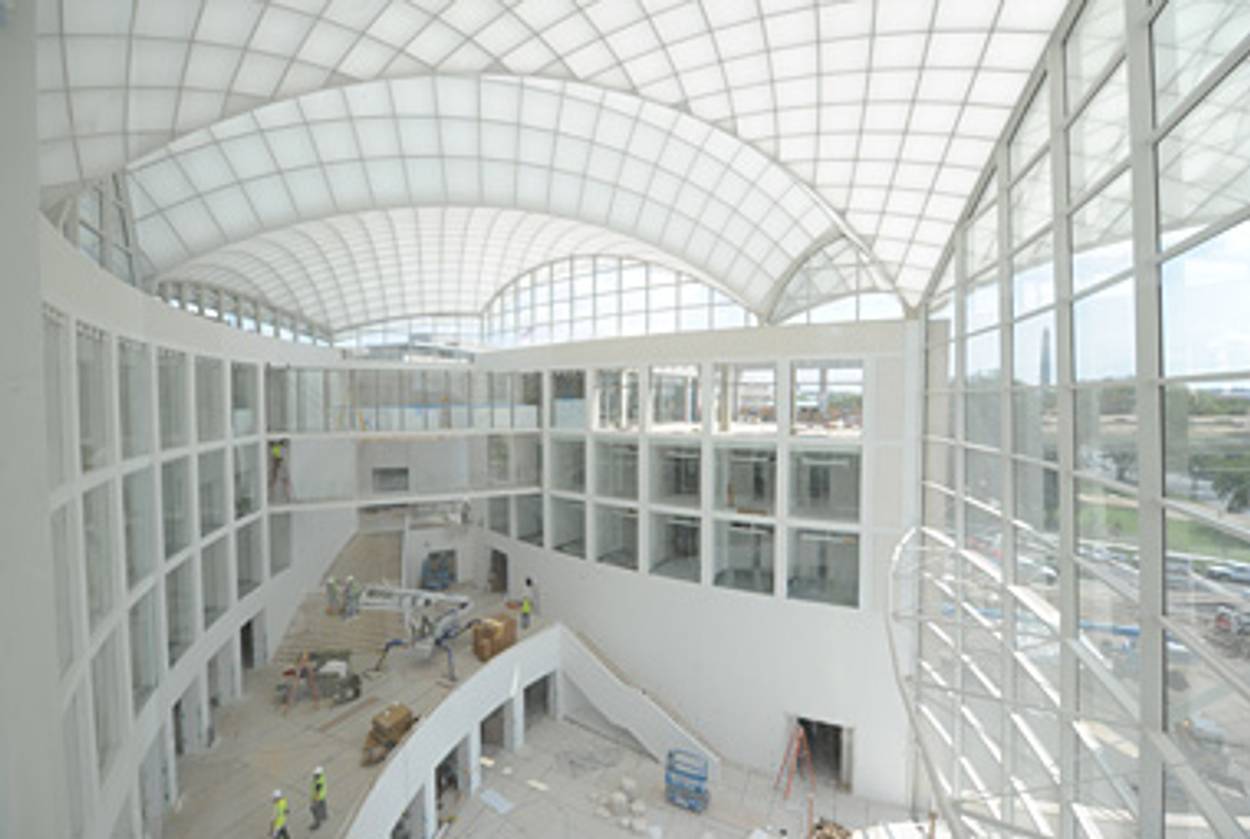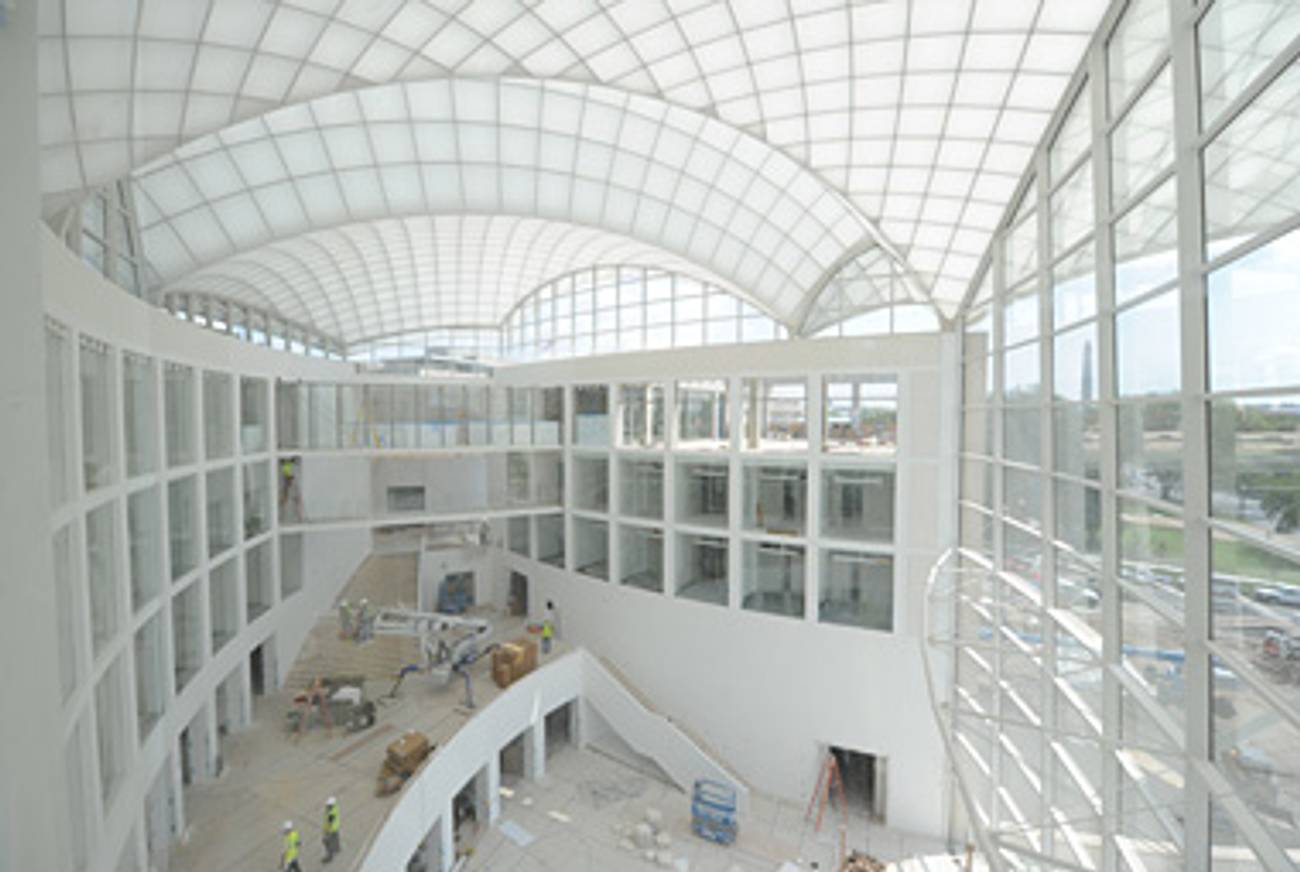Master Builder
With his U.S. Institute of Peace set to open in Washington, Israeli-born Moshe Safdie takes his place among the world’s leading architects




When tourists visit Israel, they are, more often than not, following an itinerary designed by the architect Moshe Safdie. From the grand sloping entrance hall at Ben Gurion airport—lined in golden limestone—to the sweeping vistas at Yad Vashem or the tony shops and cafes in the new Mamilla mall just outside the Old City of Jerusalem, Safdie has been singularly responsible for shaping his native country’s modern landmarks. In Canada, where he lived as a teenager, Safdie is famous as the designer of Habitat, a beehive-like housing complex in Montreal that landed him on the cover of Newsweek in 1971—and, with his shock of white hair and bushy mustache, remains so easily recognizable that customs officers sometimes greet him by name. But in the United States, where Safdie has made his home and career for the past three decades, he remains almost unknown, overshadowed by superstars like Frank Gehry, Daniel Libeskind, and Richard Meier.
Now, though, Safdie is going where his competitors have not: the National Mall in Washington, D.C., where construction is nearly complete on the $186 million headquarters Safdie designed for the United States Institute of Peace. The building, which is next door to the State Department, anchors the far western end of Constitution Avenue opposite the Lincoln Memorial—an unusually prominent site, carved out of a former Navy parking lot, that finally gives Safdie a unique opportunity to leave his mark at the symbolic center of his adopted country. “I have three passports and three citizenships, and feel very much part of all three places,” Safdie said. “But it’s evolved so that the architect of the peace institute is an Israeli. That tickles me nicely.”
The project also coincides with a traveling retrospective, Global Citizen, which opens this week at the National Gallery of Canada in Ottawa before moving to the Chicago Cultural Center and the Skirball Cultural Center, in Los Angeles, next year—and, perhaps, to Washington. “One of the great strengths of Moshe’s work is that, while it’s beautiful, it doesn’t have the eye-popping derring-do quality of a Libeskind or a Gehry,” said Donald Albrecht, the show’s curator. “But often in the media the weird or the strange take precedence.”
Safdie’s most striking commission to date is the new Marina Bay Sands resort in Singapore, which has drawn comparisons to Stonehenge for the way its rooftop garden and swimming pool cap the hotel’s three towers. But when he’s not building to compete with the skyscraping marvels of Asia’s booming cities, Safdie’s inclination is to forsake the weird and strange in favor of buildings that seem to emerge naturally from their settings. “If it’s good, then it will feel obvious and like it’s always been there,” Safdie told me over afternoon tea at his studio in Somerville, Massachusetts, outside Boston. “If it feels forced and painful and declares its presence so strongly that you can’t just be in it, then—well, I think that’s an aggressive kind of architecture that is not part of what I do.”
At 72, Safdie remains tall and lean, with a loping walk and an easy smile. He was born in Haifa, the eldest son in a Syrian-Jewish family, and moved to Canada at 15; today, he speaks perfect, unaccented English—though his enunciation of the word “project” clearly marks him as a Canadian. He has the spirit of an urban planner, and his curiosity about social innovation extends to non-architectural enterprises like the car-sharing service Zipcar. In his early career, he was a Modernist whose work revolved around creating universally replicable solutions to common urban riddles like high-density housing and mixed-use development. The Habitat complex, Safdie’s undergraduate thesis at McGill University, was built as part of the 1967 Montreal Expo, but it generated interest in similar developments in New York, San Juan, Jerusalem, and Tehran in the late 1960s and early 1970s. (None of those projects was ever built.) Safdie wound up winning his first two major commissions from religious institutions at opposite ends of the Jewish spectrum, which were both expanding in Jerusalem’s Old City in the wake of the Six-Day War: the Porat Yosef Yeshiva, a Sephardic school with alumni including Ovadia Yosef, Israel’s former Sephardic chief rabbi and a leader of the ultra-Orthodox Shas party; and the Israeli campus of the Reform Movement’s Hebrew Union College.
In the two Jerusalem projects, Safdie wound up creating a current Jewish architectural vernacular, by playing off the arched domes of Temple Mount and the narrow, open-air alleyways and courtyards of the Old City—references that echo in later projects, many of which feature multiple interior open spaces under soaring geometric skylights. “Our entrance is in the shape of a sukkah, a welcoming tent,” said Uri Herscher, president of the Skirball Center, Safdie’s first American commission, which opened in 1996. “I think he understood what it was in ancient history and Jewish tradition that would apply to contemporary society.”
Safdie’s own upbringing was essentially secular—indeed, he recalled in a program broadcast on Canadian television in 1971 that as a boy he was beaten in school for saying he believed in God. “We grew up to be suspicious of rabbis and religious authorities,” Safdie said then. But working in the environs of the Old City, where every Friday night religious Jews would come to pray at the Western Wall, forced him to think about his relationship with religion. “In other words, being a Jew all of a sudden became much more complicated than whether you went to synagogue or not,” he went on.
And being an Israeli Jew, Safdie readily acknowledges, has only grown more complicated with time. His efforts to realize a grand plan for a series of terraced plazas connecting the upper precincts of the Jewish Quarter to the Roman-era street in front of the Western Wall, 30 feet below the current level, were thwarted by the Orthodox establishment. In 2007, environmentalists torpedoed a master design, referred to as the Safdie Plan, for new construction on the western edge of Jerusalem, away from the contested Palestinian neighborhoods to the east. “It’s double standards,” he said. “Because if you’re building a road in Israel, you go through hell. You’ve got to landscape the edges, you’ve got to demonstrate that the cut and fill is okay, they have green room allowances. Build that same road across the Green Line in the Palestinian territory—and I’m talking about Israel building that road—they dump the dirt, they destroy the landscape. All of a sudden it’s not sacred ground anymore—and these are supposed to be people who love the land.”
More recently, Safdie has attracted the ire of pro-Palestinian activists opposed to a municipal urban planning project in the southern part of the city that encroaches on the East Jerusalem neighborhood of Silwan, a flashpoint for conflict. Safdie—a longtime supporter of a two-state solution and personal friend of Yitzhak Rabin’s, who designed the prime minister’s tomb and a memorial museum in Tel Aviv—said he finds it increasingly difficult to navigate the polarized politics of the city, where, according to a 2003 New Yorker profile, he once considered running for mayor. “I’ve managed to be apolitical in Israel over the years, meaning I’ve dealt with every government—I’ve dealt with Golda, I’ve dealt with Begin, I dealt with them all,” he said. “It’s getting worse and worse—it’s not getting better.” He told a story about his housekeeper, a Palestinian woman who comes from the West Bank, being taunted by boys at the yeshiva next door to his apartment, near the Muslim Quarter in the Old City, without any rebuke from the guards standing watch over the school. “They taunt her, they throw stones at her,” Safdie said, shaking his head. “It’s horrible.”
Safdie was an early and enthusiastic supporter of Barack Obama, whom he met through Samantha Power, a foreign-policy adviser who is now on the National Security Council staff and a Cambridge friend of Safdie and his wife, the photographer Michal Ronnen Safdie. In 2006, Power asked Safdie to take Obama on a tour of Yad Vashem; Safdie agreed but decided not to alert museum staff that he was bringing in an American VIP. On his office wall, Safdie has what he says is the only photograph of the visit: a 4-by-6 snapshot, unposed, of Obama leaning over a display case. He got it from a journalist who found it on a blog, where it was posted after Obama’s skeptics questioned whether the candidate had been to the museum on his trip to Israel. “It was just a tourist who then later realized what he had, and posted it,” said Safdie.
It is simply coincidence that the Institute for Peace is being finished on Obama’s watch. Commissioned in December 2001, it will have its ceremonial opening next September, in time for the 10th anniversary of the Sept. 11 terrorist attacks. “When I heard about the competition, I said, ‘What is USIP?’ And now when I give lectures I do a survey of the crowd, and usually, about 10 people will have heard about it,” Safdie explained. “So, the fact that no one knows about it and it’s a significant institution to me defined the problem—which meant you’ve really got to go for it, to make a building that is symbolically the peace institute.”
Founded in 1984, the Institute for Peace is best known for hosting the activities of the Iraq Study Group, the bipartisan panel charged with assessing policy options following the 2003 invasion. Currently housed in rented office space in central Washington, the organization’s new home features two soaring internal atriums, surrounded by offices walled entirely in floor-to-ceiling glass panes—intended to convey transparency to visitors looking in but that also afford sweeping views of the Potomac and neighboring monuments to the researchers looking out.
The challenge of building on the Mall happens to be very much like building in the Old City: The key is not to compete with the more famous monuments nearby, while still attracting attention. “You wind up having to do more inside, which is very much what Safdie had to do in Jerusalem to make his buildings fit,” said Samuel Gruber, an expert on Jewish architecture who formerly served as research director for the U.S. Commission for the Preservation of America’s Heritage Abroad. “You do everything with light and interiors, which is his strength.”
Ironically, Safdie’s only previous commission in Washington was the heavily reinforced and secured headquarters of the federal Bureau of Alcohol, Tobacco, and Firearms, which from some angles looks more than a little like a jail. By contrast, the Institute for Peace is fronted in transparent glass, sheltered by a translucent white wing that juts down over the facade, evoking a landing dove. “The site compels the architect to deal with the symbol of peace as a national icon,” Safdie said. “It abuts the Lincoln Memorial, it’s a stone’s throw from the Vietnam Memorial—so you could rise to it, or you could make it disappear. We decided to rise to the occasion, or at least try to.”
Allison Hoffman is a senior editor at Tablet Magazine. Her Twitter feed is @allisont_dc.
Allison Hoffman is a senior editor at Tablet Magazine. Her Twitter feed is @allisont_dc.